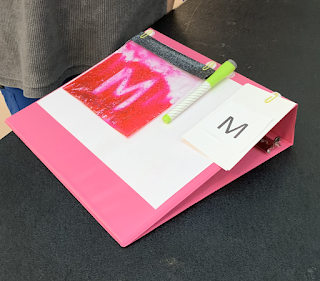Yes, teaching a child to button can be a fun experience! You might be wondering...how? First of all, don’t try to teach this skill when your little one is getting ready to leave the house in the morning., especially if you are in a hurry. That’s definitely not the time to work on buttoning and other fasteners. Instead, find a time when you can work on the skill using a fun and relaxed approach. You can also make it fun by using a button board.
Practicing on a button board will allow your child to learn and practice the skill away from their body, which makes it easier. Then once he’s learned how to manipulate the button and fabric to complete the buttoning task, he will feel more confident. That’s the time to switch over to practicing on clothing.
Skills needed for buttoning:
Able to pick up small objects using the thumb and index finger (pincer grasp)
Brings hands together at the middle of the body (midline)
Uses both hands together in a coordinated manner (bilateral skills)
Tips for teaching buttoning:
Start with large 1 to 1 ½-inch buttons, and progress to smaller ones. Initially, the fabric that the button goes through should have some stiffness to it. (You can add stiffness or body to fabric by attaching fusible or
iron-on interfacing to it.)

Now that you know how to teach buttoning, it’s time to make a button board!
Supplies Needed:
Colorful large (1 to 1 ½-inch) buttons
Felt fabric- (Let your child select the colors!)
Fabric glue or hot glue
Fusible or
Iron-on interfacing
Cardboard
1. Have your child select the “theme” for the board. (For example, see the giraffe and snowman.)
2. Cut a piece of cardboard into a rectangular shape (approximately 10-inches x 14-inches)
3. Cut out a piece of felt slightly larger than the cardboard. (12-inches x 16-inches)
4. Glue the felt onto the cardboard. Be sure to wrap the fabric around the edges of the cardboard so that it will look neat.
5. Using different color(s) of felt, cut out the shapes or forms needed for your theme, and glue those felt pieces in place on the board.
6. Iron the interfacing onto the back of the fabric or felt pieces that you plan to use for the button holes. Once the fabric has cooled, cut out the shapes or forms of your choice, then cut the appropriate sized button holes in each one.
7. You’ll need to use a sturdy needle to sew the buttons onto the board.
8. Use a Sharpie marker and other felt pieces to decorate it even more!
Finally, have fun working on those buttoning skills!
The projects above were completed by a Master of Occupational Therapy student at The University of Tennessee Health Science Center and posted with permission.



















